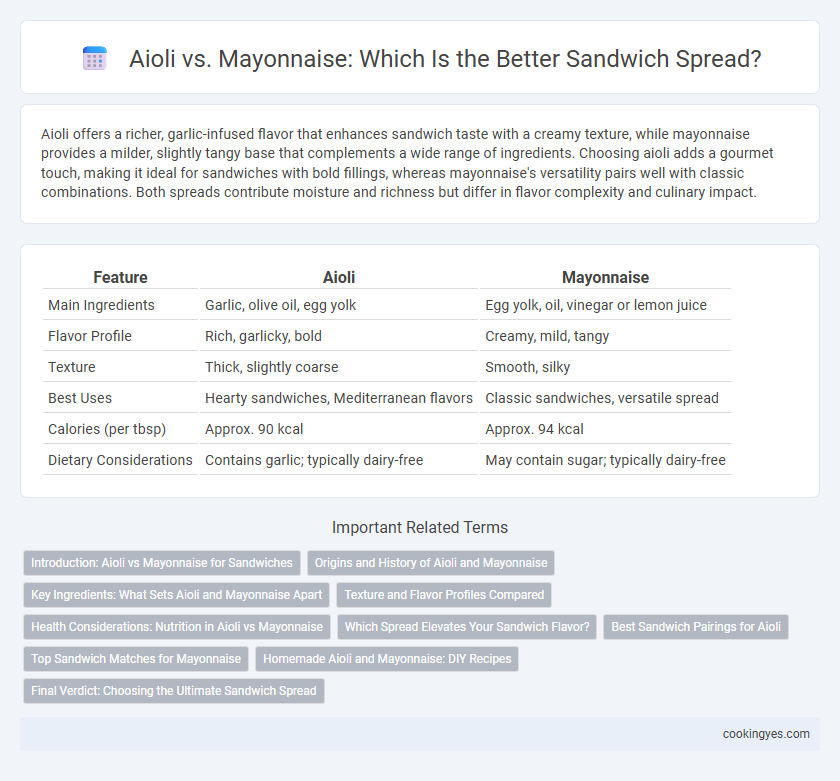Aioli offers a richer, garlic-infused flavor that enhances sandwich taste with a creamy texture, while mayonnaise provides a milder, slightly tangy base that complements a wide range of ingredients. Choosing aioli adds a gourmet touch, making it ideal for sandwiches with bold fillings, whereas mayonnaise's versatility pairs well with classic combinations. Both spreads contribute moisture and richness but differ in flavor complexity and culinary impact.
Table of Comparison
| Feature | Aioli | Mayonnaise |
|---|---|---|
| Main Ingredients | Garlic, olive oil, egg yolk | Egg yolk, oil, vinegar or lemon juice |
| Flavor Profile | Rich, garlicky, bold | Creamy, mild, tangy |
| Texture | Thick, slightly coarse | Smooth, silky |
| Best Uses | Hearty sandwiches, Mediterranean flavors | Classic sandwiches, versatile spread |
| Calories (per tbsp) | Approx. 90 kcal | Approx. 94 kcal |
| Dietary Considerations | Contains garlic; typically dairy-free | May contain sugar; typically dairy-free |
Introduction: Aioli vs Mayonnaise for Sandwiches
Aioli and mayonnaise are popular sandwich spreads that enhance flavor and texture, but they differ in ingredients and taste profiles. Aioli, traditionally made from garlic, olive oil, and egg yolks, offers a robust, savory punch, while mayonnaise combines eggs, oil, and vinegar for a creamy, mild flavor. Choosing between aioli and mayonnaise depends on the desired taste intensity and the sandwich fillings.
Origins and History of Aioli and Mayonnaise
Aioli, originating from the Mediterranean coasts of Spain and France, is traditionally made from garlic, olive oil, and egg yolks, reflecting its ancient Provencal and Catalan roots dating back to Roman times. Mayonnaise, believed to have been created in the 18th century, likely in France or Spain, combines egg yolks, oil, and vinegar or lemon juice, symbolizing a more neutral, versatile base compared to the bold flavor profile of aioli. Both spreads have evolved, with mayonnaise becoming a global sandwich staple while aioli retains its heritage as a flavorful, garlic-infused condiment.
Key Ingredients: What Sets Aioli and Mayonnaise Apart
Aioli is traditionally made from garlic, olive oil, and egg yolks, offering a robust, aromatic flavor that enhances sandwich fillings, whereas mayonnaise primarily consists of egg yolks, vegetable oil, and vinegar or lemon juice, resulting in a creamier, milder taste. The presence of fresh garlic in aioli creates a more intense, pungent profile compared to mayonnaise's neutral base, making aioli ideal for bold sandwiches like grilled chicken or roasted vegetables. Olive oil in aioli contributes a richer texture and Mediterranean essence, contrasting the lighter mouthfeel of mayonnaise crafted with neutral oils such as canola or soybean.
Texture and Flavor Profiles Compared
Aioli offers a rich, creamy texture with a garlicky punch that enhances sandwich layers without overwhelming other ingredients. Mayonnaise provides a smooth, slightly tangy texture that blends seamlessly while adding subtle moisture. The bold flavor of aioli contrasts with the milder, versatile taste of mayonnaise, allowing for choice based on desired sandwich complexity.
Health Considerations: Nutrition in Aioli vs Mayonnaise
Aioli is typically made from olive oil, garlic, and egg yolks, offering higher levels of monounsaturated fats and antioxidants that promote heart health compared to mayonnaise, which often contains soybean or canola oil with a higher polyunsaturated fat content. Mayonnaise generally has a higher calorie density and may contain more added sugars and preservatives, impacting overall nutritional value. For a healthier sandwich spread, aioli provides beneficial fats and natural ingredients, while mayonnaise may contribute to increased caloric intake and less favorable fat profiles.
Which Spread Elevates Your Sandwich Flavor?
Aioli, made with garlic and olive oil, delivers a robust, savory flavor that enhances gourmet sandwiches with a Mediterranean flair. Mayonnaise offers a creamy, mild base that complements a wide variety of sandwich ingredients without overpowering them. Choosing aioli or mayonnaise depends on whether you prefer a bold, aromatic boost or a subtle, smooth texture in your sandwich spread.
Best Sandwich Pairings for Aioli
Aioli, made from garlic, olive oil, and sometimes egg yolks, offers a robust, savory flavor that enhances hearty sandwich ingredients like grilled chicken, roasted vegetables, and Mediterranean-style fillings. Its creamy texture and bold taste complement artisanal breads such as ciabatta or sourdough, creating a gourmet sandwich experience. Unlike mayonnaise, aioli's distinct garlic undertone pairs exceptionally well with sandwiches featuring fresh herbs, sun-dried tomatoes, and aged cheeses.
Top Sandwich Matches for Mayonnaise
Mayonnaise enhances classic sandwiches like turkey club, BLT, and tuna salad by adding creamy texture and rich flavor that complements savory fillings. Its emulsified blend of oil, egg yolk, and vinegar pairs well with ingredients such as bacon, lettuce, and tomato, providing a smooth balance without overpowering the sandwich layers. Popular sandwich spots favor mayonnaise for its versatility and ability to maintain moisture in both cold and grilled sandwiches.
Homemade Aioli and Mayonnaise: DIY Recipes
Homemade aioli offers a richer, garlicky flavor made from fresh garlic, egg yolks, olive oil, and lemon juice, creating a creamy spread that enhances sandwich taste profiles. DIY mayonnaise combines egg yolks, neutral oil, vinegar or lemon juice, and mustard for a smooth, tangy base customizable with herbs or spices. Both spreads deliver freshness and control over ingredients, but aioli provides a distinctive gourmet touch ideal for elevating everyday sandwiches.
Final Verdict: Choosing the Ultimate Sandwich Spread
Aioli offers a robust garlic flavor and creamy texture that elevates sandwich taste profiles with Mediterranean flair, while mayonnaise provides a milder, versatile base that complements a wide variety of ingredients. For those seeking bold, aromatic intensity, aioli is the ultimate sandwich spread, enhancing layers of grilled meats and fresh vegetables. Conversely, mayonnaise suits those who prefer a subtle, smooth binder that melds seamlessly with classic deli fillings.
Aioli vs Mayonnaise for sandwich spread Infographic

 cookingyes.com
cookingyes.com